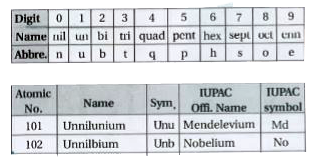Explain Nomenclature of elements having atomic number more than 100.
(A) Old method of nomenclature & controversy:
The naming of the new elements had been traditionally the privilege of the discoverer and the suggested name was ratified by the IUPAC. In recent years this has led to some controversy. The new elements with very high atomic numbers are so unstable that only minute quantities, sometimes only a few atoms of them are obtained.
Their synthesis and characterisation, therefore, require highly sophisticated costly equipment and laboratory. Such work is carried out with competitive spirit only in some laboratories in the world.
Scientists before collecting the reliable data to claim for its discovery. For example both American and soviet scientists claimed credit for discovering element 104.
The Americans named it Rutherfordium whereas soviets named it Kurchatovium.
To avoid such problems, the IUPAC has made recommendation that until a new elements discovery is proved and its name is officially recognized, a systematic nomenclature be derived directly from the atomic number of the element using the numerical roots for 0 and number 1-9.
The roots are put together in order of digits which make up the atomic number and "ium" is added at the end.
The IUPAC names for elements with Z above 100 are shown in table.
( B) Digit Name Abbreviation :


Thus, the new element first gets a temporary name, with symbol consisting of three letters.
Later permanent name and symbol are given by a vote of IUPAC representatives from each country.
The permanent name might reflect the country in which the element was discovered, or pay tribute to a notable scientist.
As of now elements with atomic numbers up to 112, 114 and 116 have been discovered.
Elements with atomic numbers 113, 115, 117 & 118 are not yet known.
Related Playlists
- BOOK - KUMAR PRAKASHANCHAPTER - CLASSIFICATION OF ELEMENTS AND PERIODICITY IN PROPERTIES EXERCISE - Section -B103videos
CLASSIFICATION OF ELEMENTS AND PERIODICITY IN PROPERTIES
- BOOK - KUMAR PRAKASHANCHAPTER - CLASSIFICATION OF ELEMENTS AND PERIODICITY IN PROPERTIES EXERCISE - Section -C (MCQs from Textual Exercise )8videos
CLASSIFICATION OF ELEMENTS AND PERIODICITY IN PROPERTIES
- BOOK - KUMAR PRAKASHANCHAPTER - CLASSIFICATION OF ELEMENTS AND PERIODICITY IN PROPERTIES EXERCISE - Section -A -1videos
CLASSIFICATION OF ELEMENTS AND PERIODICITY IN PROPERTIES
- BOOK - KUMAR PRAKASHANCHAPTER - CHEMICAL BONDING AND MOLECULAR STRUCTUREEXERCISE - SECTION -D (SOLUTIONS OF NCERT EXEMPLAR PROBLEMS) (LONG ANSWER TYPE QUESTIONS)10videos
CHEMICAL BONDING AND MOLECULAR STRUCTURE
- BOOK - KUMAR PRAKASHANCHAPTER - ENVIRONMENT CHEMISTRY EXERCISE - Question For Module (Section-C)1videos
ENVIRONMENT CHEMISTRY
Similar Questions
The element having atomic number 92
View SolutionAccording to IUPAC nomenclature the name of elements having atomic numbers 101 and 116 are
View SolutionThe elements with atomic numbers geater than 100 are:
View SolutionThe atom of the element having atomic number 14 should have
View SolutionClassification Of Elements|Nomenclature Of Elements With Atomic Number > 100|NCERT Intext Question|Concept Of Electronic Configuration|OMR|Summary
View SolutionModern Periodic Law|Periodic Table Of The Elements|Nomenclature Of Elements With Atomic Number > 100|Summary
View SolutionThe element with atomic number 9 resembles in properties with the element having atomic number
View Solution(a) Define valency of an element. What valency will be shown by an element having atomic number 14 ?
(b) What is the relation between the valency of an element and the number of valence electrons in its atoms ? Explain with examples.View SolutionThe atoms of the elements having same atomic number but different mass number are called -
View SolutionAn element having atomic number 17 will resemble which of the following elements having Atomic number as given below?
View Solution

